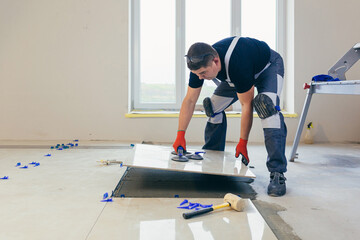There are many factors to consider before you start the tile installation process. What materials do you need, and how do you set them up? For example, do you want to do it yourself or hire a professional? Consider the risks of a tile installation job, such as mold, dust mites, and bacteria.

When it comes to tile installation, some people prefer to do it themselves. This can save money. However, it can also be a dangerous project. Tile is a physical job that requires a lot of patience and skill. If you are new to the job, it may take longer than you expect. Professional tile installers will have the proper tools and equipment to do the job correctly. They can even smooth the edges of tiles and make accurate cuts.
Setting materials are essential to the process of installing tile. This includes the materials, tools, and techniques used to set tile. There are a number of different options available, so you should choose the best for the job. You may consider the thinset method, a type of adhesive mortar. In addition to the standard sand and cement mixture, you will need to add water. However, it would be best if you were careful not to mix the product over. The amount should be just enough to saturate one grid area.
As for the actual setting, you can apply the mortar to the substrate using a trowel. This will provide a sturdy base for the tiles. You will also need to lay down the waterproofing layer. While this is not necessary for many installations, it is important in areas that are regularly exposed to moisture. Another notable mention is the mastic, a latex or solvent based adhesive. It can be found in airtight containers.
Spacers are small pieces of plastic that are used to keep tiles from being too close together. This helps in creating an even gap between the tiles and prevents the risk of dislodging or chipping them. Tile spacers are available in a range of shapes and sizes. They can be placed on both walls and floors.
For example, a T-shaped spacer has a flat end that is abutted by the wall. It is also easy to remove. The same concept is applied to a wedge spacer, which looks like a door stop. A u-shaped spacer is similar, but the flat end is placed against a vertical surface.
These spacers are designed to sit between the tiles during installation. They help maintain a consistent gap between the tiles and give a professional finish to the entire job. There are many types of spacers to choose from, ranging in size and design from simple rectangular shapes to complex geometric designs.
Mould, dust mites, bacteria, and other allergens. Allergens are compounds that irritate the immune system and may lead to allergic diseases. These include dust mites, bacteria, viruses, and pollen. They may cause physical and mental symptoms depending on the person and their specific conditions. Dust mites are tiny insects that feed on dead skin scales. They are not known to bite people. However, they are considered to be a major source of indoor allergens. In fact, 30% of the United States population is sensitive to the feces of these mites.
Molds are fungi that can cause negative health effects. Their spores are always floating in the air. Some molds can produce highly toxic chemicals called mycotoxins. The effects of exposure to mycotoxins vary from minor to serious. Some bacteria can also produce harmful chemicals. For example, gram-negative bacteria have endotoxins in the cell walls. This endotoxin is the primary hazard of bacterial contamination. Molds are often found in damp areas of buildings, which encourages their growth. The best way to control mold growth is to keep the relative humidity below 50%.
The cost of hiring a professional can be higher than a DIY project. But it can be worth the money. Depending on the size of the project, it could save you time and money in the long run. You’ll avoid any hassles in the future and have your project completed in a timely manner.
One of the main reasons to hire a professional for your tile installation is because of the quality of work they can do. Some tiles are difficult to fit together. Others require precise alignment. And some tiles are made of fragile materials, so the chances of cracking are high.